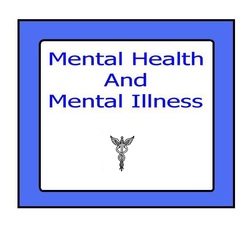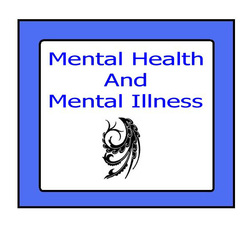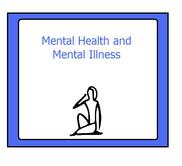
Before we can begin the exploration into the world of mental illness we have to consider two significant aspects of the development of the science of the mind and cultural expectations and popular understanding.
The first important factor to look at is the historical view that we have had about the condition of mental illness, and how we perceive it currently.
For most of our past history until the middle of the 20th century, mental illness has been poorly understood and very poorly managed. The fact that anyone who exhibited behavior that was atypical or significantly out of the norm, suggested that they should be isolated from the "normal" population and secured lest they hurt themselves, or others. From early medieval times, it was the church that determined whether or not an individual was either just blasphemous, or was truly insane. (Insane by the way is a legal term and not a clinical definition). But, the only way to isolate anyone was to create an ersatz "treatment facility" but in reality, a prison, where treatment was essentially non-existent. Even into the early 20th century, treatment consisted of submerging a patient in ice cold water, deprivation of food, and water, and not allowing interaction with other patients. But, simultaneously, the science of psychiatry was being developed and non-typical behavior was being reconsidered as a disease or illness. And, with both WWI and WWII, the reality of "shell shock" the precursor to PTSD, post traumatic stress disorder, was recognized and the effort to treat rather than isolate became more common.
But, in the 1960's and 1970's, many changes began to redefine mental behavior and to look at hospitalization as a sentence and not a cure. Medications had been developed that could significantly reduce symptoms of many mental illnesses, and psychiatry had become a mainstream treatment modality. A bold new idea was becoming a real plan to treat mental illness. The concept was simple; set up treatment centers that were staffed with a psychiatrist, therapists, and mental health professionals, and begin to have patients in hospitals return to their homes and community to be re-integrated into a more normal setting to recover. Please notice that I have not used the word "cure" as many mental illnesses are not curable but rather can be managed to provide some level of consistency for the patient. The treatment center concept was a means for supporting recovery and providing a significantly better quality of life. And, to a large degree, the concept has been successful. There are now treatment centers across the US and these are funded by State and Federal dollars, as well as by private money. But, that is not the end of the story.
We still have the stigma of mental illness as a problem no matter how it is treated. We have a patchwork of cultural understanding and tolerance. For family members dealing with mental illness or developmental disability there is an understanding of the difficulty and challenges facing chronic illness patients. For mental health professionals, the challenge is to find new ways to educate the public and increase the opportunity to assist those with marginal capabilities. But, there is always the persistent misconception that mental illness equals danger. There are many crime dramas and news stories about serial killers, sociopaths, psychopaths, and the threat to personal safety. I would be remiss to say that these threats do not exist, but the reality is that the threat is much less than the perception would suggest. I will not shy away from this reality but it is more important to look at the successes rather than the failures. It is the same as believing that because there are traffic fatalities, we will all be a statistic.
In the next post we will consider how a mental illness is diagnosed, and how treatment is determined. But, I would like to offer a link to NAMI, The Alliance on Mental Illness, a national organization for the dissemination of information and resources for the public. Here. Thanks for following these posts, Ken...
The first important factor to look at is the historical view that we have had about the condition of mental illness, and how we perceive it currently.
For most of our past history until the middle of the 20th century, mental illness has been poorly understood and very poorly managed. The fact that anyone who exhibited behavior that was atypical or significantly out of the norm, suggested that they should be isolated from the "normal" population and secured lest they hurt themselves, or others. From early medieval times, it was the church that determined whether or not an individual was either just blasphemous, or was truly insane. (Insane by the way is a legal term and not a clinical definition). But, the only way to isolate anyone was to create an ersatz "treatment facility" but in reality, a prison, where treatment was essentially non-existent. Even into the early 20th century, treatment consisted of submerging a patient in ice cold water, deprivation of food, and water, and not allowing interaction with other patients. But, simultaneously, the science of psychiatry was being developed and non-typical behavior was being reconsidered as a disease or illness. And, with both WWI and WWII, the reality of "shell shock" the precursor to PTSD, post traumatic stress disorder, was recognized and the effort to treat rather than isolate became more common.
But, in the 1960's and 1970's, many changes began to redefine mental behavior and to look at hospitalization as a sentence and not a cure. Medications had been developed that could significantly reduce symptoms of many mental illnesses, and psychiatry had become a mainstream treatment modality. A bold new idea was becoming a real plan to treat mental illness. The concept was simple; set up treatment centers that were staffed with a psychiatrist, therapists, and mental health professionals, and begin to have patients in hospitals return to their homes and community to be re-integrated into a more normal setting to recover. Please notice that I have not used the word "cure" as many mental illnesses are not curable but rather can be managed to provide some level of consistency for the patient. The treatment center concept was a means for supporting recovery and providing a significantly better quality of life. And, to a large degree, the concept has been successful. There are now treatment centers across the US and these are funded by State and Federal dollars, as well as by private money. But, that is not the end of the story.
We still have the stigma of mental illness as a problem no matter how it is treated. We have a patchwork of cultural understanding and tolerance. For family members dealing with mental illness or developmental disability there is an understanding of the difficulty and challenges facing chronic illness patients. For mental health professionals, the challenge is to find new ways to educate the public and increase the opportunity to assist those with marginal capabilities. But, there is always the persistent misconception that mental illness equals danger. There are many crime dramas and news stories about serial killers, sociopaths, psychopaths, and the threat to personal safety. I would be remiss to say that these threats do not exist, but the reality is that the threat is much less than the perception would suggest. I will not shy away from this reality but it is more important to look at the successes rather than the failures. It is the same as believing that because there are traffic fatalities, we will all be a statistic.
In the next post we will consider how a mental illness is diagnosed, and how treatment is determined. But, I would like to offer a link to NAMI, The Alliance on Mental Illness, a national organization for the dissemination of information and resources for the public. Here. Thanks for following these posts, Ken...



 RSS Feed
RSS Feed
